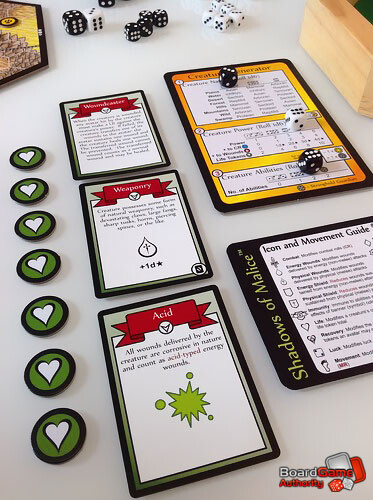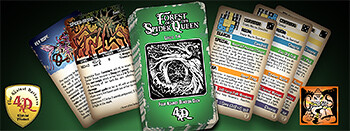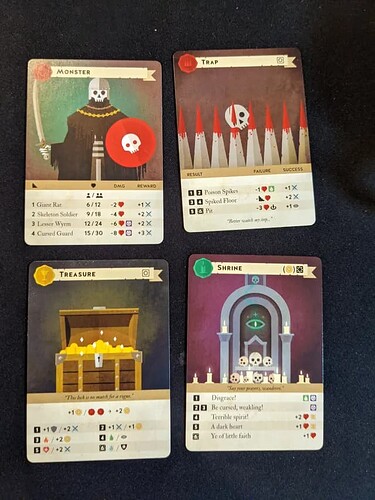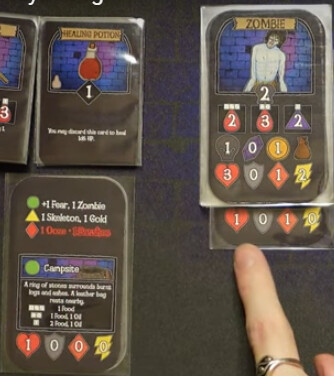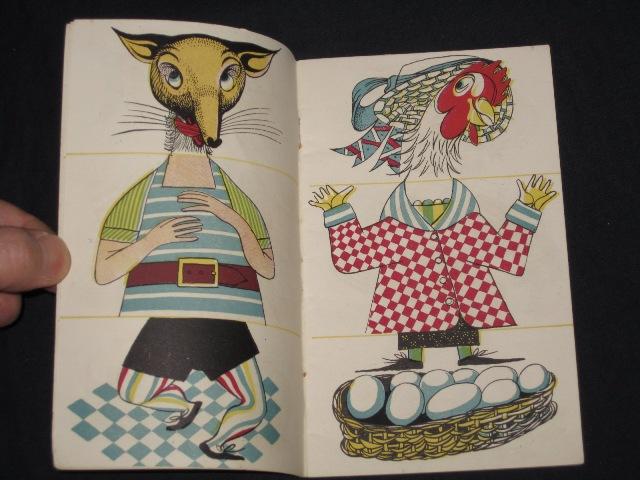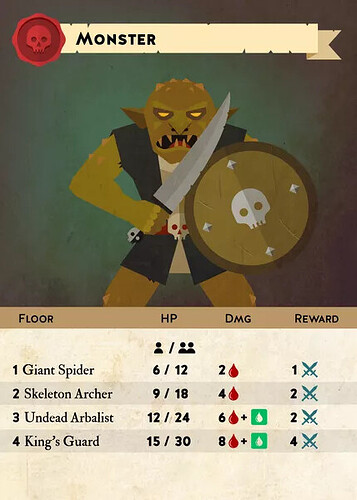Hi All!
I’m reach out looking for help and inspiration. I’ve been working on “my ideal dungeon crawler” for a long time and who knows when I’ll ever have enough time and really get there but…
There is a mechanic I’m trying to capture, that I first encountered in Shadows of Malice, and it was brought back to my attention in Daniels own project A Land in Peril.
It is the idea that, with a small table and a bunch of cards, you can create TONS of enemies. The image below shows that I’m talking about:
You roll on a table for what kind of enemy you’re going to face, how powerful it is, and how many abilities it has, and draw a card or two to make it unique and interesting. I LOVE THIS!!! I love the way it makes a tremendous amount of variation with so little.
Dungeons of Doria also does something like this with its enemy deck where you can draw additional abilities that make the enemies you draw tougher.
I also want to point out that the 4AD decks do something like this, with each card having a PART of the picture, and you draw several to flesh out the whole picture:
A lot of oracle decks do things like this. I love multi-use cards, so, so very much.
Mini Rogue does something clever, putting multiple enemies on just a few cards, where depending on what LEVEL you encounter an enemy, determines what kind of enemy it is:
Unfortunately for my purposes, these stat blocks are a little small, I’m interested in creating more complex enemies.
The new mint tin game Crypt Crawler creates random stack blocks for specific enemies by slipping 1 or more additional stack blocks under the specific enemy:
So here is what I’m trying to do… I’m trying to take the general idea of using FEWER MATERIALS and combining them for GREATER DIVERSITY.
But I’m trying to see if it works for something specific I’m trying to do for my own system.
Here is how my system works so far (Edited For Clarity (thanks Genghis-Prawn!!!):
-
Each player starts with a 5 torch cards in hand, and 1 torch card in the fray (a pile of face down cards at the center of the table). Each player has their own torch corresponding to them. So one player might be red, all of their torches are red, another player might be blue, all their torches are blue. This is so it is clear which torch corresponds to which player.
-
A group of adventurers enter a room, each one of them seeing something different. Depending on the room, each player draws X cards from a dungeon deck and adds it to their hand initially containing their 5 torches. The dungeon deck contains enemies, traps, features, events, etc… all things you would encounter in a dungeon room. One player might draw a hand of 3 enemies and a treasure chest, another player might draw a hand of something completely different.
-
The Draft The adventurers think quickly, whisper something to each other, pointing, shouting, yelling for help, lying, and begin to move. Players are free to negotiate, share information, lie etc… but at this point:
a. Each player takes 1 card from their hand and adds it to the fray face down.
b. Then each player chooses 5 cards to keep in their hand, and pass the rest to the player to their left. This process is repeated until each player is left with only 5 cards in hand.
This is a twist on a “draft” where the players are collectively drafting the the fray instead of choosing which cards to keep for themselves.
- The Fray The dungeon responds based on the choices the players collectively made. Once each player only has 5 cards left in hand, the fray is shuffled, and laid out from left to right. Each time a player’s torch is revealed, all of the cards revealed prior to it are assigned to the player whose torch was revealed. For example, I reveal 3 enemies in a row, then reveal player 2s torch… this means that all 3 of those enemies go after player 2.
In short, in many dungeon crawlers where you would have AI rules about which enemy attacks which player, or roll a die to determine… this system instantly assigns enemies to players based on the position of their torch with respect to the enemy in the fray as it is laid out.
- Once all of the enemies have been assigned, the players interact with:
a. the cards that they kept in their hand at the end of the draft
b. all of the cards that they were randomly assigned from the fray.
Say there was a treasure chest in your hand during the draft… by keeping it it in your hand by the end of the draft, you must have passed along, or put one of your torches into the fray. Say you have a magic sword that is effective against ghosts… maybe you want to keep the ghosts in your hand since you’re the one who is effective at fighting them, rather than risk another player who is not-prepared fighting them.
In short, the fray is a randomization mechanism, where what you keep in your hand during the draft is essentially what you, the player, are CHOOSING to interact with… while the fray mechanism is choosing what you MUST interact with. Everyone is operating with partial information, and potentially selfish aims.
(I’m hoping this is a clearer explanation… maybe I need pictures!)
Now here is what I want to do:
I want to have less cards. Right now, I have 1 enemy on each card, and would need a ton of cards to make this an interesting and varied dungeon.
Somehow, I want to randomly? generate a diversity of enemies with interesting abilities and effects… while using this drafting/fray mechanism. I can’t just have several cards with different bits of information that that end up combining into single enemies. Some of them are kept, passed along, added to “the fray” and shuffled, and re-distributed. I want the information the players to have to be meaningful as they’re making decisions. I also want it to be quick, and not have to look up a ton of information on tables. Maybe a table or two? But not bog down the game trying to keep information in mind while you’re looking at your hand during each round of the draft.
Help me with this! Is it even possible? Any creative designers have ideas of how to do this? It is a very physical problem and I have a few thoughts but I’m looking for something exceedingly clever that will make me Chef’s Kiss.
Please ask me clarifying questions if what I’m describing doesn’t make sense. I’m really looking for input and inspiration from mechanically inclined folks and experienced dungeon divers that have seen neat ideas in the games they’ve played.
Thank you!
